10.3 Soil Formation
Steve Earle
Weathering is a key part of the process of soil formation, and soil is critical to our existence on Earth. In other words, we owe our existence to weathering, and we need to take care of our soil!
Many people refer to any loose material on Earth’s surface as soil, but to geologists (and geology students) soil is the material that includes organic matter, lies within the top few tens of centimetres of the surface, and is important in sustaining plant growth. Other types of soft sediments can be described using terms that are indicative of how they formed, such as glacial till, river-deposited sand and gravel, lake-deposited clay, and wind-blown silt.
Soil is a complex mixture of minerals (approximately 45%), organic matter (approximately 5%), and empty space (approximately 50%, filled to varying degrees with air and water). The mineral content of soils is variable, but is dominated by clay minerals and quartz, along with minor amounts of feldspar and small fragments of rock. The types of weathering that take place within a region have a major influence on soil composition and texture. For example, in a warm climate, where chemical weathering dominates, soils tend to be richer in clay. Soil scientists describe soil texture in terms of the relative proportions of sand, silt, and clay, as shown in Figure 10.3.1. The sand and silt components in this diagram are dominated by quartz, with lesser amounts of feldspar and rock fragments, while the clay component is dominated by the clay minerals.
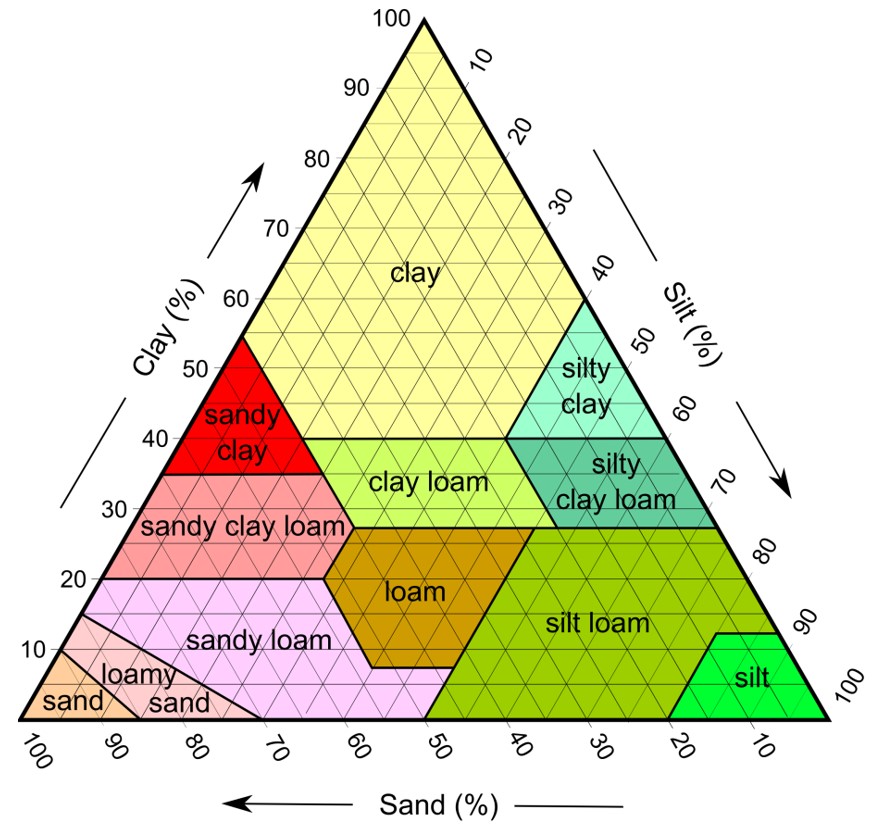
Soil forms through accumulation and decay of organic matter and through the mechanical and chemical weathering processes described above. The factors that affect the nature of soil and the rate of its formation include climate (especially average temperature and precipitation amounts), organisms (especially the types and intensity of vegetation), relief (the slope and aspect of the surface) the type of parent material, and the amount of time available. These are known by the acronym CLORPT, coined by Hans Jenny in 1941.[1]
Climate
Soils develop because of the weathering of materials on Earth’s surface, including the mechanical breakup of rocks, and the chemical weathering of minerals. Soil development is facilitated by the downward percolation of water. Soil forms most readily under temperate to tropical conditions (not cold) and where precipitation amounts are moderate (not dry, but not too wet). Chemical weathering reactions (especially the formation of clay minerals) and biochemical reactions proceed fastest under warm conditions, and plant growth is enhanced in warm climates. Too much water (e.g., in rainforests) can lead to the leaching of important chemical nutrients and hence to acidic soils. In humid and poorly drained regions, swampy conditions may prevail, producing soil that is dominated by organic matter. Too little water (e.g., in deserts and semi-deserts), results in very limited downward chemical transportation and the accumulation of salts and carbonate minerals (e.g., calcite) from upward-moving water. Soils in dry regions also suffer from a lack of organic material (Figure 10.3.2).
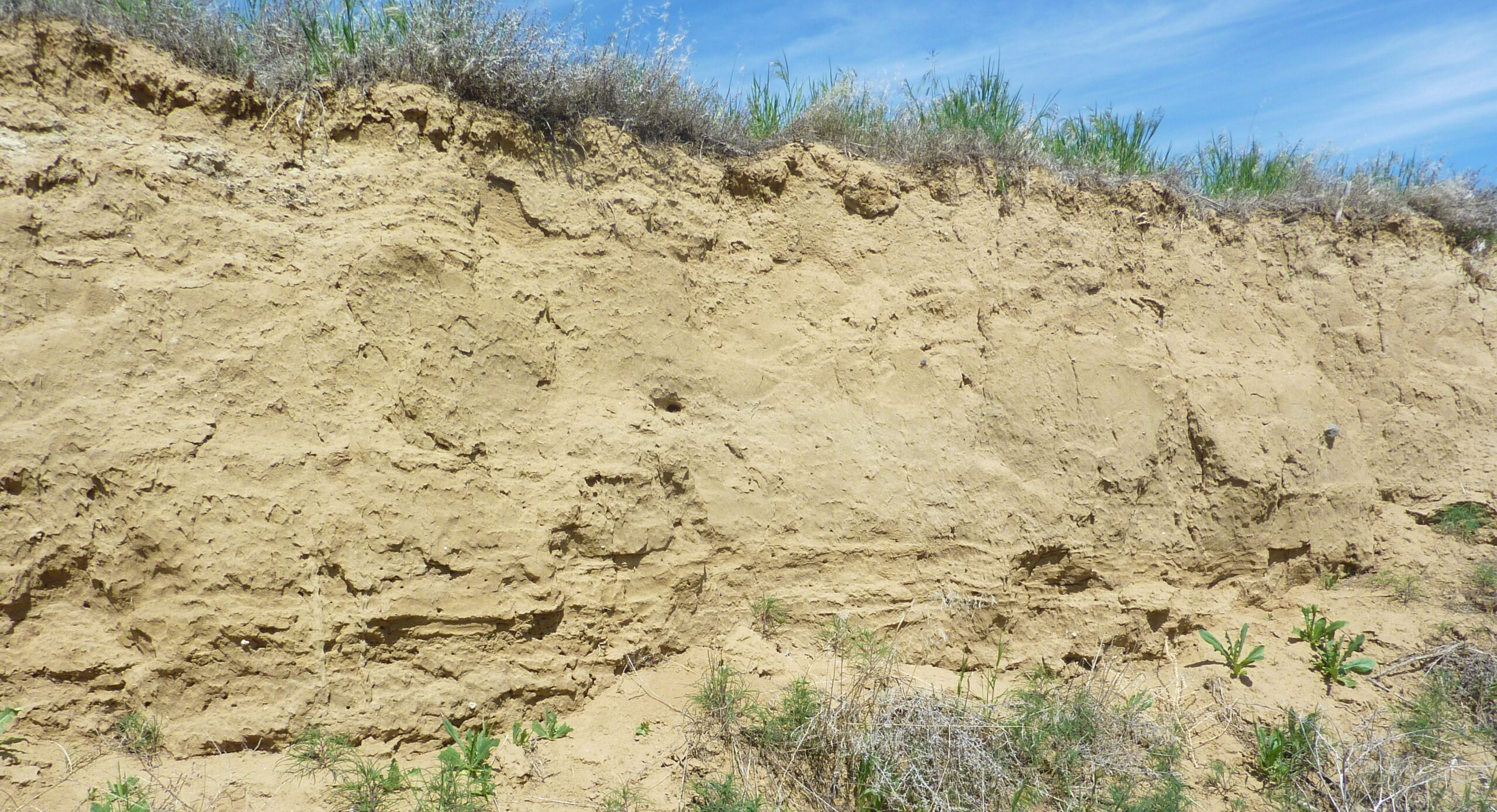
Organic matter
Good soil is rich in organic matter, and that can only accumulate if there is sufficient plant growth in the area. There is only sparse vegetation growing in the area of Figure 10.3.2, and the soil is poor.
Relief
Soil can only develop where surface materials remain in place and are not frequently moved away by mass wasting. Soils cannot develop where the rate of soil formation is less than the rate of erosion, so steep slopes tend to have little or no soil.
Parent Material
Soil parent materials can include all different types of bedrock and any type of unconsolidated sediments, such as glacial deposits and stream deposits. Soils are described as residual soils if they develop on bedrock and transported soils if they develop on transported material such as glacial sediments. Other sources may use the term “transported soil” to imply that the soil itself has been transported, but in this text “transported soil” is soil that is developed on transported materials, like the very thin soil shown in Figure 10.3.2. When referring to such soil, it is better to be specific and say “soil developed on unconsolidated material,” because that distinguishes it from soil developed on bedrock.
Quartz-rich parent material, such as granite, sandstone, or loose sand, leads to the development of sandy soils. Quartz-poor material, such as shale or basalt, generates soils with little sand, and in some cases with elevated clay levels.
Parent materials provide important nutrients to residual soils. For example, a minor constituent of granitic rocks is the calcium-phosphate mineral apatite (Ca5(PO4)3(F,Cl,OH)), which is a source of the important soil nutrient phosphorus. Basaltic parent material tends to generate very fertile soils because it also provides phosphorus, along with significant amounts of iron, magnesium, and calcium. As described in Chapter 7, soils in active volcanic regions tend to be generally quite fertile, partly because the fine-grained and glass-rich eruption products weather quickly and produce significant amounts of clay that hold trace elements.
Some unconsolidated materials, such as river-flood deposits, make for especially good soils because they also tend to be rich in clay minerals. Clay minerals have large surface areas with negative charges that are attractive to positively charged elements like calcium, magnesium, iron, and potassium—important nutrients for plant growth.
Time
Even under ideal conditions, soil takes thousands of years to develop. Virtually all of southern Canada and parts of the northern US were still glaciated up until 14 ka. Glaciers still dominated the central and northern parts of Canada until around 10 ka, and so, at that time, conditions were still not ideal for soil development even in the southern regions. Therefore, soils in Canada, and especially in central and northern Canada, are relatively young and not well developed.
The same applies to soils that are forming on newly created surfaces, such as recent deltas or sand bars, or in areas of mass wasting. Climate and parent material both exert a significant control on how long it takes for soil to develop.
Soil formation
The process of soil formation is summarized on Figure 10.3.3. The left-hand diagram shows the situation of the site within several years of the exposure of the rock surface (for example, following deglaciation). The rock is fractured and both mechanical and chemical weathering have started. Lichen and moss are present on the rock surface and small plants have started to grow in cracks and depressions in the outcrop where small amounts of sediment have accumulated.
The second diagram represents a time some hundreds to thousands of years later (longer in cold and dry climates). Both mechanical and chemical weathering of the rock are well advanced. The rock is softer and weaker than it was originally and the weathering products have accumulated in between the remaining rock fragments. The C horizon soil has developed from the products of weathering (small rock fragments, sand, and clay) and organic matter is accumulating near to surface.
The third diagram is a few thousand to several thousand years later. The soil profile has started to evolve, mostly through chemical changes involving both downward and upward motion of ions in water, and transfer of water and chemicals by the roots of plants and mycorrhizal networks.
The last diagram, on the right, represents a time several thousands to tens of thousands of years later. The soil is now well developed. There has been significant weathering of minerals like feldspar and amphibole within the soil to produce clay minerals and there has also been upward and downward movement of chemicals (iron, manganese, potassium, sodium, calcium, magnesium, and aluminum). Along with all of the living organisms (roots, mycorrhizae, worms, insects), there is a great deal of carbon stored in the soil (as organic matter, charcoal, carbon dioxide and methane). Depending on the type of parent material and the rate of soil formation in the local climate, the soil in this last diagram could be from several centimetres to over a metre thick.
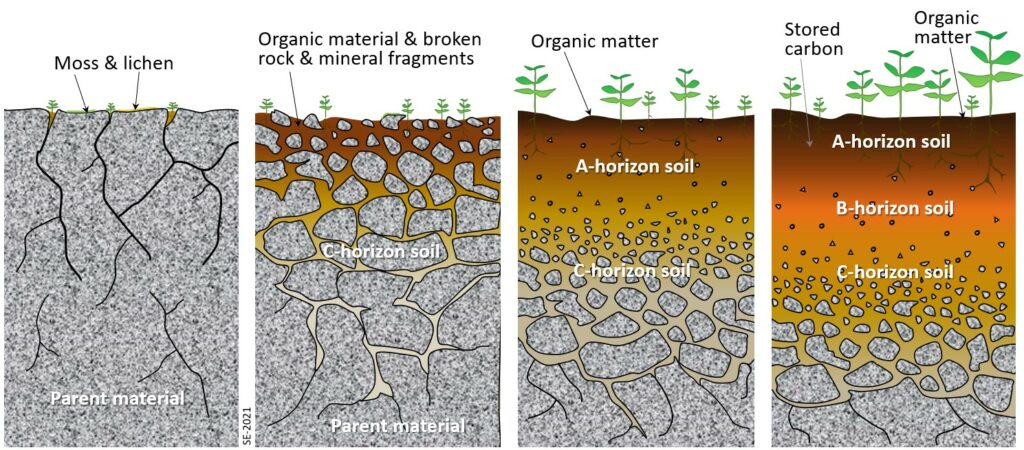
Soil Horizons
The process of soil formation generally involves the downward movement of clay, water, and dissolved ions, and a common result of that is the development of chemically and texturally different layers known as soil horizons. The typically developed soil horizons, as illustrated in Figure 10.3.4, are:
O – a layer of organic matter,
A – a layer of partially decayed organic matter mixed with mineral material
E – an eluviated (leached) layer from which some of the clay and iron have been removed to create a pale layer that may be sandier than the other layers
B – a layer of accumulation of clay, iron, and other elements from the overlying soil
C – a layer of incomplete weathering, which grades down into unaltered parent material
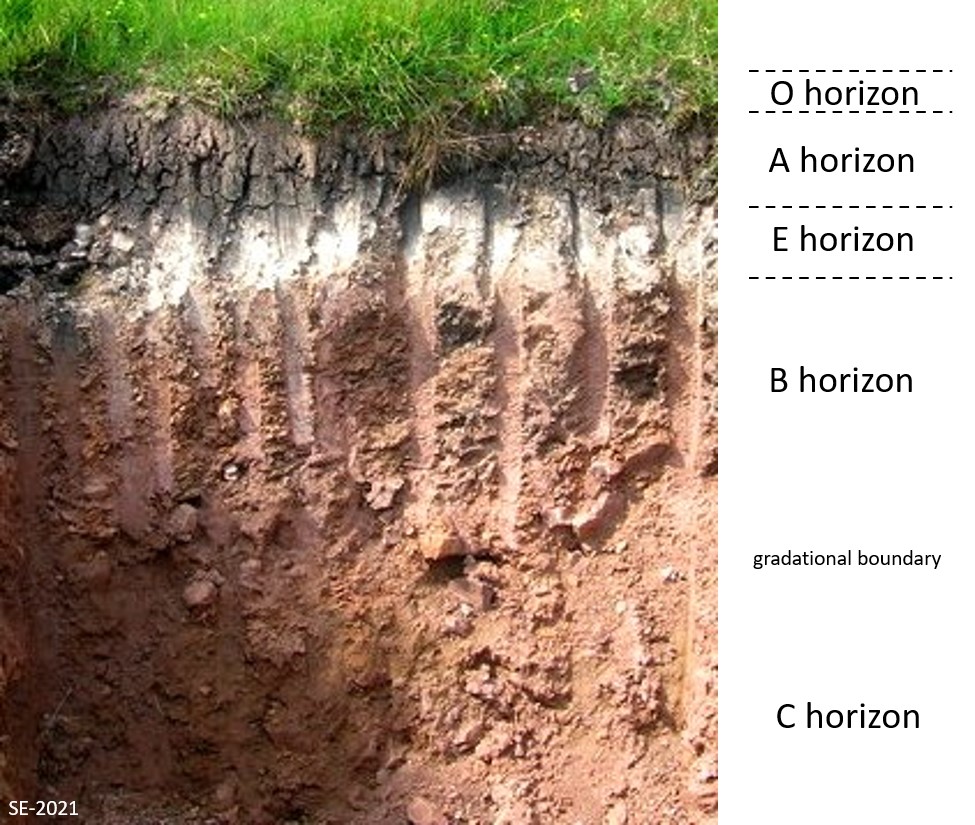
Like all geological materials, soil is subject to erosion, although under natural conditions on gentle slopes, the rate of soil formation either balances or exceeds the rate of erosion. Human practices, especially those related to forestry and agriculture, have significantly upset this balance in many places.
Soils are held in place by vegetation. When vegetation is removed, either through cutting trees or routinely harvesting crops and tilling the soil, that protection is either temporarily or permanently lost.
The primary agents of the erosion of unprotected soil are water and wind. Water erosion is accentuated on sloped surfaces because fast-flowing water obviously has greater eroding power than slow-flowing or still water (Figure 10.3.5). Raindrops can disaggregate exposed soil particles, putting the finer material (e.g., clays) into suspension in the water. Sheet wash—unchanneled flow across a surface—carries suspended material away, and channels erode right through the soil layer, removing both fine and coarse material.
Soil Erosion

Wind erosion is exacerbated by the removal of trees that act as wind breaks and by agricultural practices that leave bare soil exposed (Figure 10.3.6).
Tillage is also a factor in soil erosion, especially on slopes, because each time the soil is lifted by a cultivator, it is moved a few centimetres down the slope.
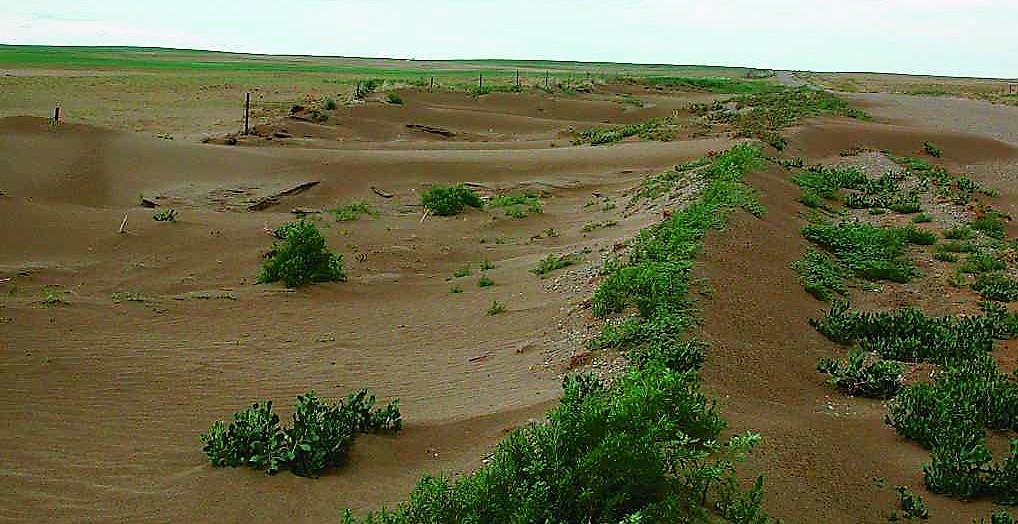
Media Attributions
- Figure 10.3.1 USDA Soil Texture by Christopher Aragón, CC BY SA 4.0, via Wikimedia Commons, https://commons.wikimedia.org/wiki/File:USDA_Soil_Texture.svg
- Figure 10.3.2 Photo by Steven Earle, CC BY 4.0
- Figure 10.3.3 Steven Earle, CC BY SA 4.0
- Figure 10.3.4 Modified photo by Steven Earle, CC BY SA 4.0, from Podzol by Ailith Stewart, via geograph.org, CC BY SA 2.0, https://www.geograph.org.uk/photo/218892
- Figure 10.3.5 Image from Alberta Agriculture and Rural Development, http://www1.agric.gov.ab.ca/$department/deptdocs.nsf/all/agdex9313. Used with permission, all rights reserved.
- Figure 10.3.6 Image from Alberta Agriculture and Rural Development, http://www1.agric.gov.ab.ca/$department/deptdocs.nsf/all/agdex9313. Used with permission; all rights reserved.
- Jenny, H. (1941). Factors of soil formation—a system of quantitative pedology. McGraw-Hill. ↵
